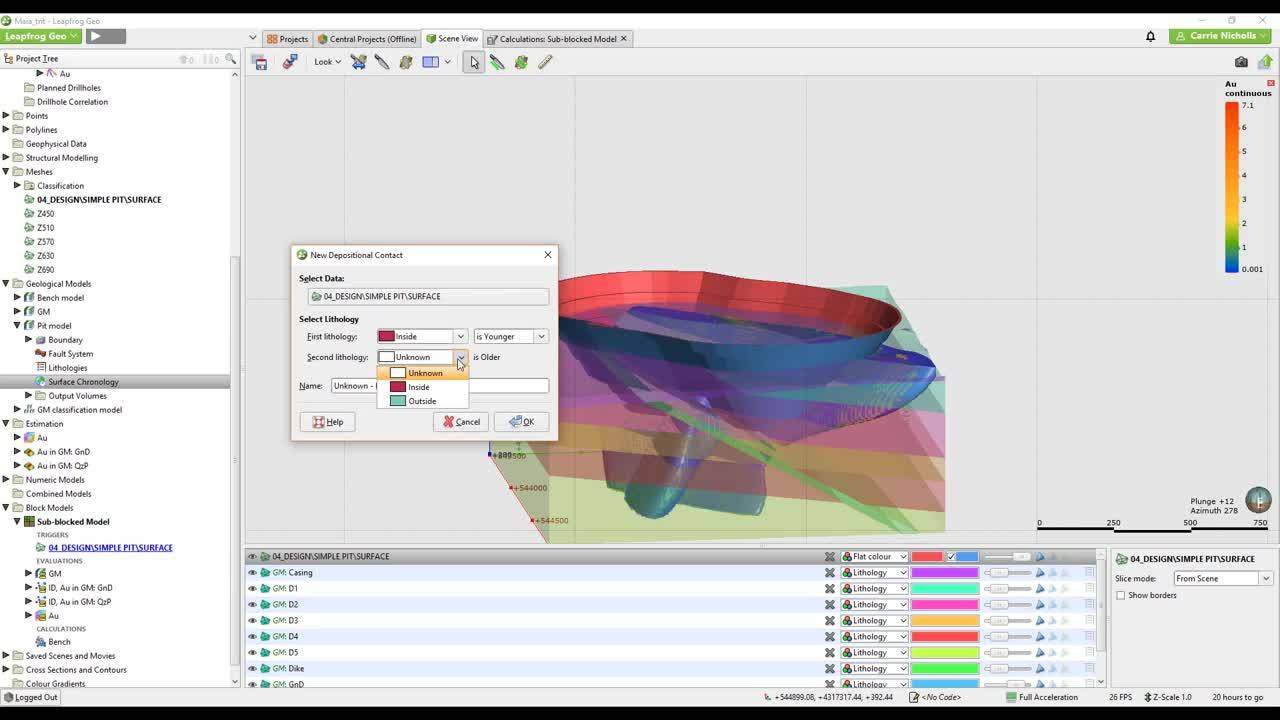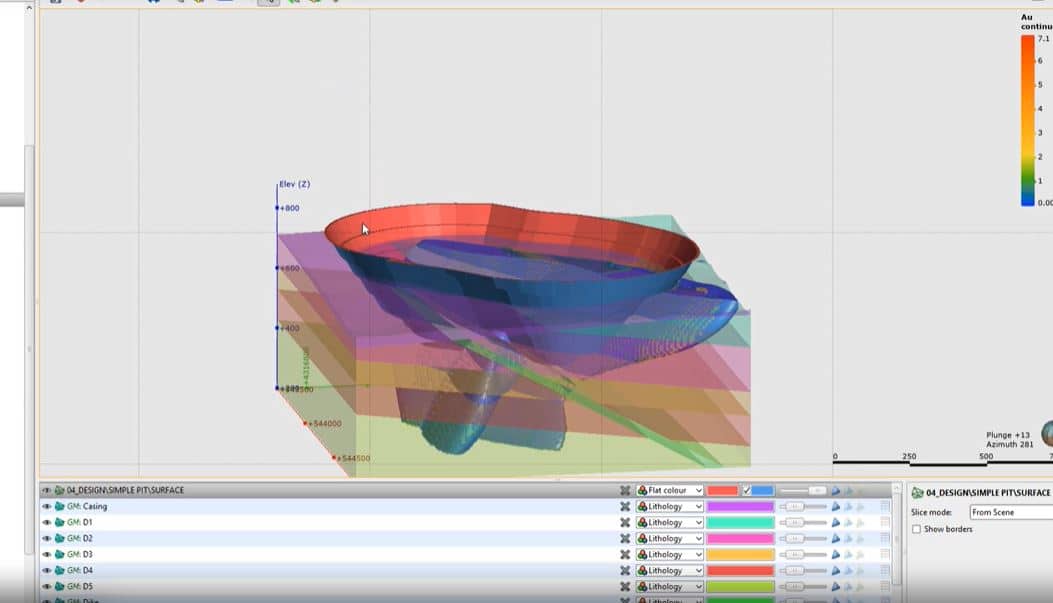In this video we go through creating a simple open pit categorical model to use in the reporting of resources on the block model in Leapfrog Edge.
Duration
5 min

See more on demand videos
VideosFind out more about Seequent's mining solution
Learn moreVideo Transcript
[00:00:00.581]
(soothing music)
[00:00:05.340]
<v Instructor>In this video,</v>
[00:00:06.173]
I’m going to take you through creating a pit model,
[00:00:08.300]
which can be used in the reporting of estimates.
[00:00:10.960]
The basis of the method is to create a categorical model
[00:00:14.120]
to code onto the block model and to do this,
[00:00:16.130]
we’ll use the geological modeling tools.
[00:00:18.510]
I’ve already created a geological model,
[00:00:20.410]
which you can see in the scene here
[00:00:22.380]
and I’ve estimated gold
[00:00:23.700]
into a couple of the domains already.
[00:00:26.370]
So let’s go and make our pit model.
[00:00:28.300]
So come to geological models, new geological model.
[00:00:33.460]
Now, the base lithology column, I’m going to set to none,
[00:00:36.620]
because I’m not going to use any
[00:00:38.810]
of the coding from the drill holes
[00:00:40.920]
because that’s not going to be relevant to me.
[00:00:45.270]
Enclose object, the quickest way is
[00:00:47.560]
to use a pre-existing model,
[00:00:48.950]
so I’m just going to use my domaining model.
[00:00:53.810]
And then just rename, pit model.
[00:01:00.080]
Before I start creating the pit model,
[00:01:02.470]
I need to put some coding into the lithologies table.
[00:01:06.630]
Because we use the base lithology column of none,
[00:01:10.000]
I have nothing in here.
[00:01:11.770]
So I need to add a couple, so I just want what’s inside
[00:01:14.510]
and what’s outside of the pit.
[00:01:15.880]
It’s just the one pit I have.
[00:01:18.270]
So it’s just very simple inside, outside, okay.
[00:01:25.796]
(soothing music)
[00:01:28.910]
So this is the pit I’m going to use, the pit mesh.
[00:01:32.690]
You can see that Leapfrog has recognized
[00:01:35.180]
that this side of the pit, which is the inside is, is red
[00:01:38.670]
and the outside of the pit is blue.
[00:01:42.380]
So this is just important to note for
[00:01:44.490]
when you start building your model.
[00:01:47.490]
So you can define what’s the first lithology
[00:01:50.220]
and the second lithology.
[00:01:51.970]
So this is probably the more logical way to think of it.
[00:01:56.640]
And you could always reverse the polarity of your meshes
[00:01:59.624]
if it’s reversing what you expect it to do.
[00:02:04.600]
To do that, you open
[00:02:08.000]
and you can invert mesh orientation here.
[00:02:13.190]
I won’t do that now.
[00:02:15.950]
So, back on my pit model, surface chronology,
[00:02:18.890]
new deposit from surface, I’m going to use that mesh.
[00:02:24.990]
There we go.
[00:02:27.040]
So the first lithology, which is younger,
[00:02:29.780]
is going to be inside my pit.
[00:02:31.730]
So I’m going to use that inside coding.
[00:02:34.320]
And my second lithology is going to be outside.
[00:02:41.730]
So I can activate this.
[00:02:44.860]
I’m going to set the background lithology to outside
[00:02:47.580]
and press okay.
[00:02:50.600]
And then I’ve got inside and outside.
[00:02:53.480]
So let’s just switch these others off.
[00:03:00.730]
And that looks correct.
[00:03:03.520]
So I will go ahead and evaluate this onto my block model.
[00:03:08.760]
Pit model, just bring it across onto the evaluations
[00:03:12.850]
and let that run.
[00:03:17.490]
So now I will just double check on my model
[00:03:19.810]
to see that that has coded on as I was expecting.
[00:03:23.030]
Pit model, switch this off.
[00:03:28.572]
So I can see, yes, red inside
[00:03:30.770]
and this funny green on the outside.
[00:03:35.840]
So let’s go ahead and make a resource report.
[00:03:39.840]
To make a resource report,
[00:03:40.860]
you need a category on your model.
[00:03:42.680]
So, well, at least one category.
[00:03:46.260]
I’m going to use my domain model
[00:03:48.120]
so I can report by domain and my pit model,
[00:03:51.890]
and then my combined AU,
[00:03:54.330]
which is basically for both of my domains
[00:03:56.610]
that I’ve estimated.
[00:03:58.690]
I need to select or tell it what units to use.
[00:04:02.470]
Now, I’ve also got these invalid values here.
[00:04:05.490]
So this is just where there are blocks
[00:04:08.050]
in these domains that have not been estimated.
[00:04:13.320]
So just by applying a cutoff, we’ll get rid of those blocks.
[00:04:17.580]
And now I can see down the bottom here,
[00:04:20.470]
the two domains that I did estimate.
[00:04:23.760]
And you can switch which way round you view this,
[00:04:27.603]
and you can see that I’ve got zero tonnes for most of these
[00:04:34.230]
because I didn’t do any estimates,
[00:04:36.760]
so I can just switch those off.
[00:04:40.780]
I can change the units as well,
[00:04:42.470]
so let’s put that back to ounces,
[00:04:45.960]
and decimal places and things you can sort out.
[00:04:52.310]
Not interested in the unknown, okay.
[00:04:54.750]
So now I’ve got inside and outside,
[00:04:58.160]
which is useful to have, but in my case now,
[00:05:01.870]
I only want to report inside the pit.
[00:05:04.410]
So, the best thing to do now would be to apply a filter
[00:05:07.430]
so I can get rid of this column.
[00:05:08.970]
So I’m going to go back onto my block model here,
[00:05:11.870]
right click and select calculations and filters.
[00:05:16.030]
New filter.
[00:05:21.210]
Inside the pit.
[00:05:22.940]
And then I’m just going to use the items I have on my model.
[00:05:26.640]
And then the syntax is here.
[00:05:28.020]
So, where the pit model equals, expand that out, inside,
[00:05:34.130]
so that’s going to be my filter for inside the pit.
[00:05:39.060]
I’ll just come back to the scene to check
[00:05:40.550]
that this filter’s done correctly.
[00:05:44.570]
Inside, so yeah, it’s filtered my model out.
[00:05:47.980]
So if I change that to AU.
[00:05:50.120]
Yep, that’s definitely worked.
[00:05:52.070]
I can go back to my resource report, select the filter,
[00:05:56.690]
and now I can take off this column here, I don’t need that.
[00:06:02.630]
And there’s my report for my estimates within a pit.
[00:06:07.850]
I can go ahead and copy this table out
[00:06:09.790]
and paste it into Excel.
[00:06:12.490]
I hope that was useful for you.
[00:06:14.060]
If you have any questions, please contact us
[00:06:17.600]
on your local support email address, or office.
[00:06:21.810]
(soothing music)





